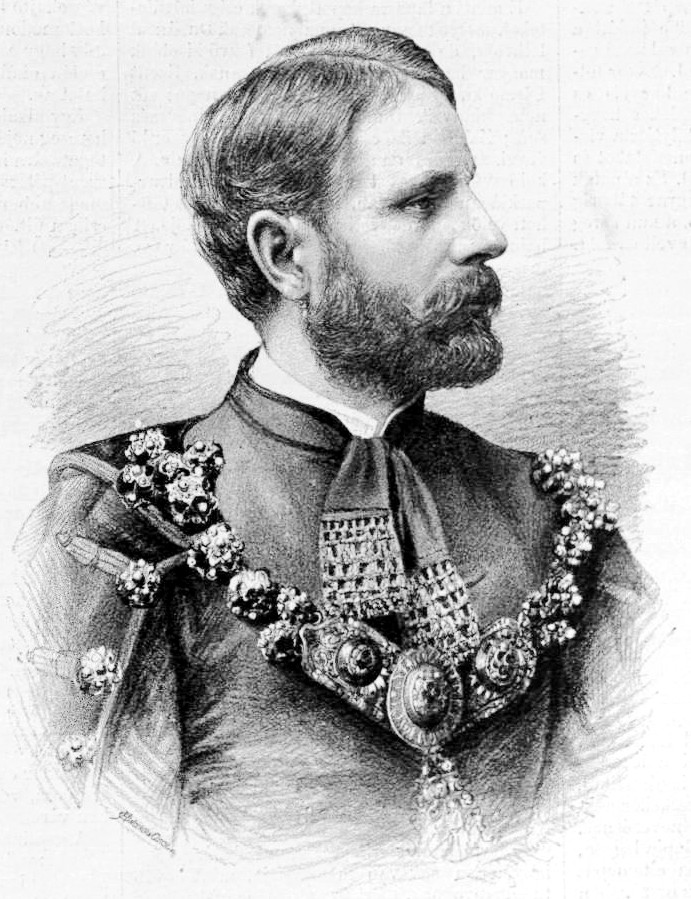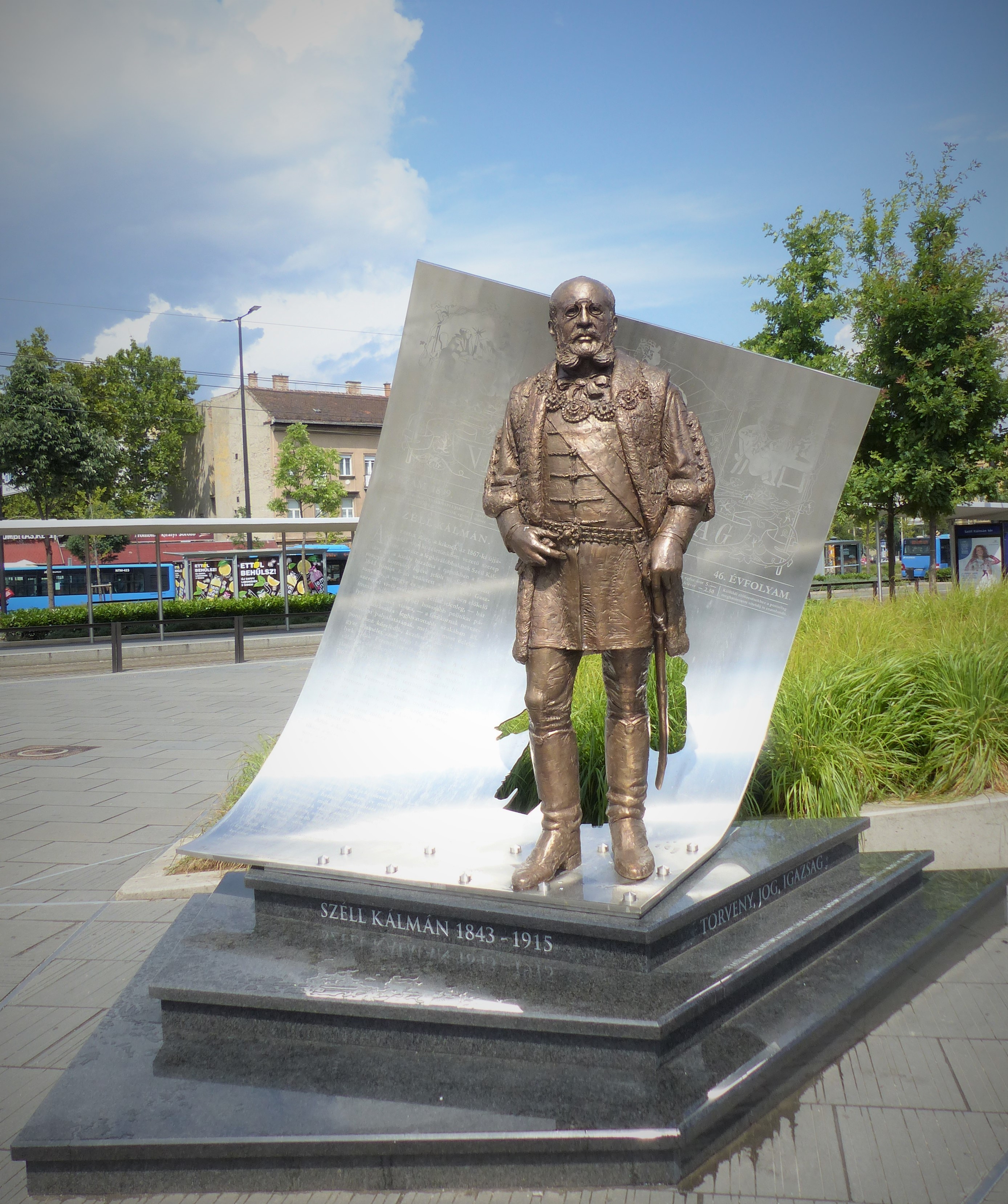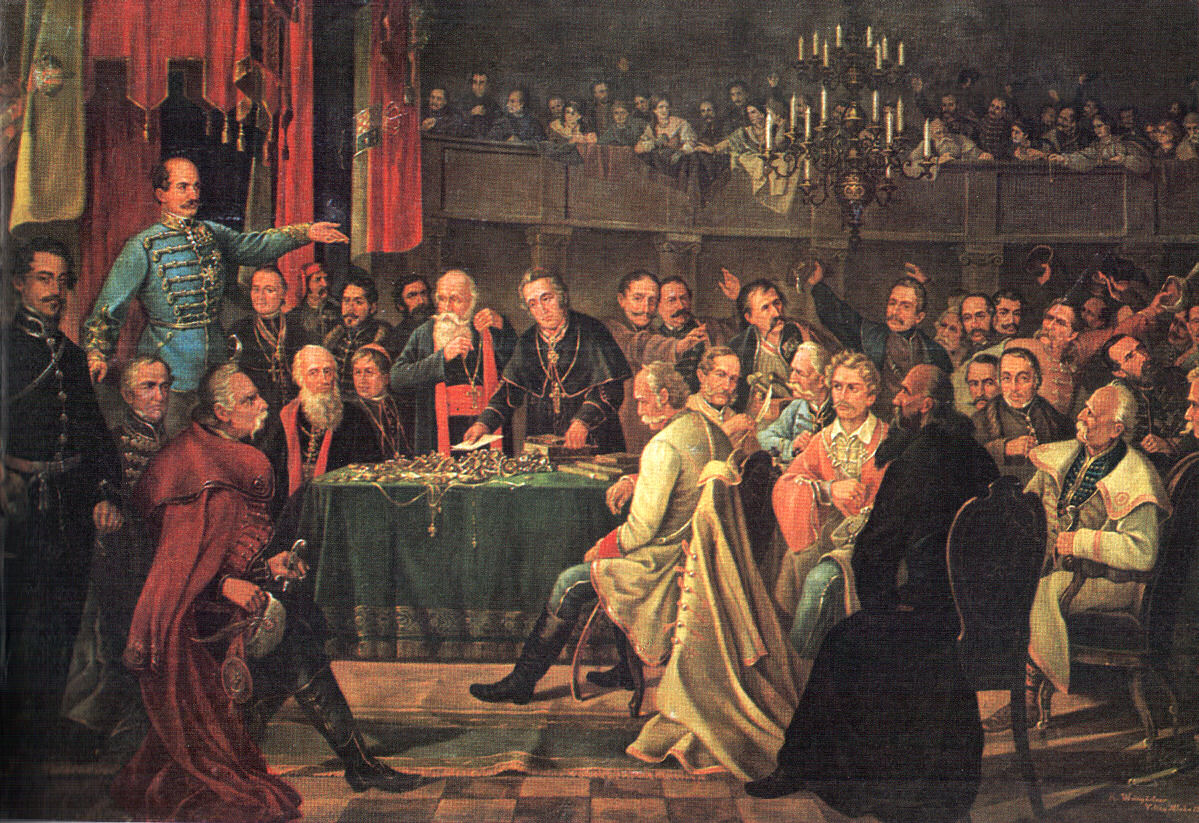|
Ervin Cseh
Ervin Cseh (23 March 1838 – 12 June 1918) was a Hungarian politician from Slavonia, who served as Minister without portfolio of Croatian Affairs twice: between 1898–1903 and between 1903–1905. As leader of Srijem County he succeeded to reconcile the Serbs and the Croatians. He was a representative in the Croatian Parliament beside his ministry. At the time of Mozaffar al-Din Shah Qajar, the Persian shah's visit in Budapest besides many people he was also favoured with the Order of the Lion and the Sun. Cseh also hold his position in the next government, but he had to leave when Kálmán Széll resigned in 1903. After Károly Khuen-Héderváry Count Károly Khuen-Héderváry de Hédervár, born as ''Károly Khuen de Belás'' ( hr, Dragutin Khuen-Héderváry, 23 May 1849 – 16 February 1918) was a Hungarian politician and the Ban of the Kingdom of Croatia-Slavonia in the late nine ...'s unsuccessful forming of a government he returned to the ministerial seat. In ... [...More Info...] [...Related Items...] OR: [Wikipedia] [Google] [Baidu] |
Minister Of Croatian Affairs Of Hungary
The Minister of Croatian Affairs of Hungary ( hu, horvát-szlavón-dalmát tárca nélküli miniszter; hr, hrvatsko-slavonsko-dalmatinski ministar bez lisnice) was a member of the Hungarian cabinet in Austria-Hungary. The position was created following the Croatian–Hungarian Agreement in 1868. The minister was appointed by the emperor-king. The officeholder kept a connection between Croatia-Slavonia-Dalmatia and the Hungarian Kingdom (and also the Austrian part of Austria-Hungary). This position was without portfolio. History of the position In accordance with the Article 44 of the Croatian–Hungarian Settlement the position of minister without portfolio emerged, representing the interests of Croatia-Slavonia and Dalmatia in the Hungarian cabinet, who became responsible to the National Assembly in Pest (later Budapest), which also functioned as a joint legislature after 1868 (however the separately administered Dalmatia sent delegates to the Imperial Council, not the Hunga ... [...More Info...] [...Related Items...] OR: [Wikipedia] [Google] [Baidu] |
Srijem County
Syrmia County ( hr, Srijemska županija, sr, Сремска жупанија, hu, Szerém vármegye, german: Komitat Syrmien) was a historic administrative subdivision (''županija'') of the Kingdom of Croatia-Slavonia. Croatia-Slavonia was an autonomous kingdom within the Lands of the Crown of Saint Stephen (Transleithania), the Hungarian part of Austria-Hungary. The region of Syrmia is today split between Croatia and Serbia. The capital of the county was Vukovar ( hu, Vukovár). Geography Syrmia County shared borders with other Croatian-Slavonian counties of Požega and Virovitica, the Austro-Hungarian land of Bosnia and Herzegovina, the Kingdom of Serbia, and the Hungarian counties of Bács-Bodrog and Torontál. The County stretched along the right (southern) bank of the river Danube and the left (northern) bank of the river Sava, down to their confluence. Its area was 6,866 km² around 1910. Background By the 13th century, two counties were formed in this r ... [...More Info...] [...Related Items...] OR: [Wikipedia] [Google] [Baidu] |
1918 Deaths
This year is noted for the end of the World War I, First World War, on the eleventh hour of the eleventh day of the eleventh month, as well as for the Spanish flu pandemic that killed 50–100 million people worldwide. Events Below, the events of World War I have the "WWI" prefix. January * January – 1918 flu pandemic: The "Spanish flu" (influenza) is first observed in Haskell County, Kansas. * January 4 – The Finnish Declaration of Independence is recognized by Russian Soviet Federative Socialist Republic, Soviet Russia, Sweden, German Empire, Germany and France. * January 9 – Battle of Bear Valley: U.S. troops engage Yaqui people, Yaqui Native American warriors in a minor skirmish in Arizona, and one of the last battles of the American Indian Wars between the United States and Native Americans. * January 15 ** The keel of is laid in Britain, the first purpose-designed aircraft carrier to be laid down. ** The Red Army (The Workers and Peasants Red Army) ... [...More Info...] [...Related Items...] OR: [Wikipedia] [Google] [Baidu] |
1838 Births
Events January–March * January 10 – A fire destroys Lloyd's Coffee House and the Royal Exchange in London. * January 11 – At Morristown, New Jersey, Samuel Morse, Alfred Vail and Leonard Gale give the first public demonstration of Morse's new invention, the telegraph. * January 11 - A 7.5 earthquake strikes the Romanian district of Vrancea causing damage in Moldavia and Wallachia, killing 73 people. * January 21 – The first known report about the lowest temperature on Earth is made, indicating in Yakutsk. * February 6 – Boer explorer Piet Retief and 60 of his men are massacred by King Dingane kaSenzangakhona of the Zulu people, after Retief accepts an invitation to celebrate the signing of a treaty, and his men willingly disarm as a show of good faith. * February 17 – Weenen massacre: Zulu impis massacre about 532 Voortrekkers, Khoikhoi and Basuto around the site of Weenen in South Africa. * February 24 – U.S. Representatives William J. Gra ... [...More Info...] [...Related Items...] OR: [Wikipedia] [Google] [Baidu] |
Károly Khuen-Héderváry
Count Károly Khuen-Héderváry de Hédervár, born as ''Károly Khuen de Belás'' ( hr, Dragutin Khuen-Héderváry, 23 May 1849 – 16 February 1918) was a Hungarian politician and the Ban of the Kingdom of Croatia-Slavonia in the late nineteenth century. Khuen's reign was marked by a strong magyarization. After a series of riots broke out against him in 1903, Khuen was relieved of his duty and appointed prime minister of Hungary. Background Born in Bad Gräfenberg, Austrian Silesia, Károly Khuen de Belás was the oldest son of seven siblings born to Hungarian magnate Antal Khuen de Belás (1817–1886) and his wife, Baroness Angelika Izdenczi de Monostor et Komlós (1823–1894). * Alice (1850–1879), wife of Count Zsigmond Zichy de Zich et Vásonykeö, an Imperial and Royal Chamberlain, Lieutenant, they married 8 January 1877 * Antal (1852–1890), Imperial and Royal Chamberlain, member of the Sabor, prominent architect * Angelika (1855–1918), wife of Count Albert vo ... [...More Info...] [...Related Items...] OR: [Wikipedia] [Google] [Baidu] |
Kálmán Széll
Kálmán Széll de Duka et Szentgyörgyvölgy (8 June 1843 – 16 August 1915) was a Hungarian politician who served as Prime Minister of Hungary from 1899 to 1903. Early career He was born in the ancient Hungarian noble family Széll de Duka et Szentgyörgyvölgy, that originally hailed from Vas county, in the western region of the Kingdom of Hungary. His father was József Széll (1801-1871), ispán-regent of Vas county, and his mother was a noblewoman, Júlia Bertha de Felsőőr (1817–1873). Among his Hungarian noble ancestors were his maternal grandfather, Ignác Bertha de Felsőeőr (1780-1847), vice-ispán of Vas county, jurist, landowner, and his maternal great-grandfather, József Sümeghy de Lovász et Szentmargitha (1757–1832), royal counselor, jurist, landowner, and vice-ispán of Zala County. He studied in Pest and Vienna, and in 1867 became deputy for the district of Szentgotthárd. He quickly garnered the reputation of being remarkably well inform ... [...More Info...] [...Related Items...] OR: [Wikipedia] [Google] [Baidu] |
Order Of The Lion And The Sun
The Imperial Order of the Lion and the Sun (Persian: نشان سلطنتی شیر و خورشید) was instituted by Fat’h Ali Shah of the Qajar dynasty in 1808 to honour foreign officials (later extended to Iranians) who had rendered distinguished services to Iran. In 1925, under the Pahlavi dynasty the Order continued as the Order of Homayoun with new insignia, though based on the Lion and Sun motif. This motif was used for centuries by the rulers of Iran, being formally adopted under Mohammad Shah. The order is abbreviated as KLS, for ''Knight of Lion and Sun''. The order was senior to the Order of the Crown. It was issued in five grades. In literature * Anton Chekhov has a short story titled ''The Lion And The Sun''. The story is about a mayor who had "long been desirous of receiving the Persian order of The Lion and the Sun". See also * Lion and Sun * Order of Aftab * Order of the Red Lion and the Sun * Neshan-e Aqdas * Order of Zolfaghar Notes *On 6 September 1900, ... [...More Info...] [...Related Items...] OR: [Wikipedia] [Google] [Baidu] |
Budapest
Budapest (, ; ) is the capital and most populous city of Hungary. It is the ninth-largest city in the European Union by population within city limits and the second-largest city on the Danube river; the city has an estimated population of 1,752,286 over a land area of about . Budapest, which is both a city and county, forms the centre of the Budapest metropolitan area, which has an area of and a population of 3,303,786; it is a primate city, constituting 33% of the population of Hungary. The history of Budapest began when an early Celtic settlement transformed into the Roman town of Aquincum, the capital of Lower Pannonia. The Hungarians arrived in the territory in the late 9th century, but the area was pillaged by the Mongols in 1241–42. Re-established Buda became one of the centres of Renaissance humanist culture by the 15th century. The Battle of Mohács, in 1526, was followed by nearly 150 years of Ottoman rule. After the reconquest of Buda in 1686, the ... [...More Info...] [...Related Items...] OR: [Wikipedia] [Google] [Baidu] |
Mozaffar Al-Din Shah Qajar
Mozaffar ad-Din Shah Qajar ( fa, مظفرالدین شاه قاجار, Mozaffar ad-Din Ŝāh-e Qājār; 23 March 1853 – 3 January 1907), was the fifth shah of Qajar Iran, reigning from 1896 until his death in 1907. He is often credited with the creation of the Persian Constitution of 1906, which he approved of as one of his final actions as Shah. Biography The son of the Qajar ruler Naser al-Din Shah Qajar, Mozaffar al-Din was named crown prince and sent as governor to the northern province of Azerbaijan in 1861. He spent his 35 years as crown prince in the pursuit of pleasure; his relations with his father were frequently strained, and he was not consulted in important matters of state. Thus, when he ascended the throne in May 1896, he was unprepared for the burdens of office. At Mozaffar al-Din's accession Persia faced a financial crisis, with annual governmental expenditures far in excess of revenues as a result of the policies of his father. During his reign, Mozzafar ad ... [...More Info...] [...Related Items...] OR: [Wikipedia] [Google] [Baidu] |
Croatian Parliament
The Croatian Parliament ( hr, Hrvatski sabor) or the Sabor is the unicameral legislature of the Republic of Croatia. Under the terms of the Croatian Constitution, the Sabor represents the people and is vested with legislative power. The Sabor is composed of 151 members elected to a four-year term on the basis of direct, universal and equal suffrage by secret ballot. Seats are allocated according to the Croatian Parliament electoral districts: 140 members of the parliament are elected in multi-seat constituencies. An additional three seats are reserved for the diaspora and Croats in Bosnia and Herzegovina, while national minorities have eight places reserved in parliament. The Sabor is presided over by a Speaker, who is assisted by at least one deputy speaker (usually four or five deputies). The Sabor's powers are defined by the Constitution and they include: defining economic, legal and political relations in Croatia, preservation and use of its heritage and entering in ... [...More Info...] [...Related Items...] OR: [Wikipedia] [Google] [Baidu] |
Croats
The Croats (; hr, Hrvati ) are a South Slavic ethnic group who share a common Croatian ancestry, culture, history and language. They are also a recognized minority in a number of neighboring countries, namely Austria, the Czech Republic, Germany, Hungary, Italy, Montenegro, Romania, Serbia, Slovakia and Slovenia. Due to political, social and economic reasons, many Croats migrated to North and South America as well as New Zealand and later Australia, establishing a diaspora in the aftermath of World War II, with grassroots assistance from earlier communities and the Roman Catholic Church. In Croatia (the nation state), 3.9 million people identify themselves as Croats, and constitute about 90.4% of the population. Another 553,000 live in Bosnia and Herzegovina, where they are one of the three constituent ethnic groups, predominantly living in Western Herzegovina, Central Bosnia and Bosnian Posavina. The minority in Serbia number about 70,000, mostly in Voj ... [...More Info...] [...Related Items...] OR: [Wikipedia] [Google] [Baidu] |
Serb
The Serbs ( sr-Cyr, Срби, Srbi, ) are the most numerous South Slavs, South Slavic ethnic group native to the Balkans in Southeastern Europe, who share a common Serbian Cultural heritage, ancestry, Culture of Serbia, culture, History of Serbia, history and Serbian language, language. The majority of Serbs live in their nation state of Serbia, as well as in Bosnia and Herzegovina, Croatia, Montenegro, and Kosovo. They also form significant minorities in North Macedonia and Slovenia. There is a large Serb diaspora in Western Europe, and outside Europe and there are significant communities in North America and Australia. The Serbs share many cultural traits with the rest of the peoples of Southeast Europe. They are predominantly Eastern Orthodox Christians by religion. The Serbian language (a standardized version of Serbo-Croatian) is official in Serbia, co-official in Kosovo and Bosnia and Herzegovina, and is spoken by the plurality in Montenegro. Ethnology The identity ... [...More Info...] [...Related Items...] OR: [Wikipedia] [Google] [Baidu] |










.png)